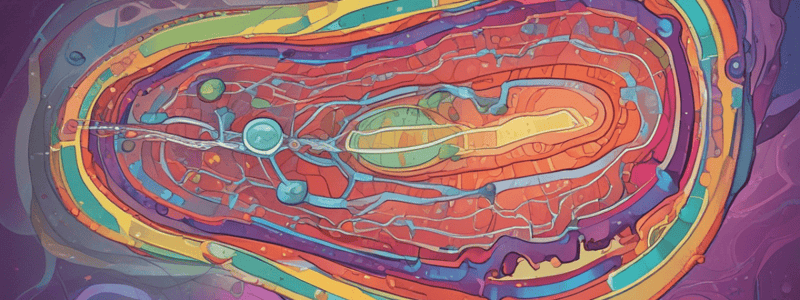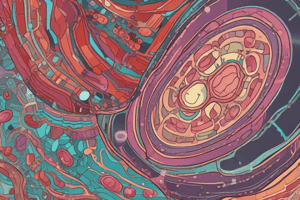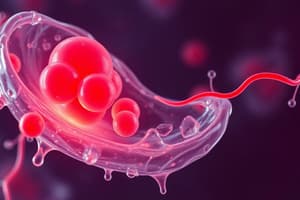Podcast
Questions and Answers
Which peroxin is responsible for recognizing N-terminal peroxisomal signal sequences?
Which peroxin is responsible for recognizing N-terminal peroxisomal signal sequences?
- Pex5
- Pex14
- Pex3
- Pex7 (correct)
What is unique about the peroxisomal translocator compared to ER translocators?
What is unique about the peroxisomal translocator compared to ER translocators?
- It can transport only small molecules.
- It can transport only lipids.
- It can transport only unfolded proteins.
- It can transport fully folded and oligomeric proteins. (correct)
What is the function of mitochondria?
What is the function of mitochondria?
- Protein synthesis
- Cell signaling
- Cell division
- ATP synthesis (correct)
Where are most mitochondrial proteins encoded?
Where are most mitochondrial proteins encoded?
What is the role of signal sequences in mitochondrial precursor proteins?
What is the role of signal sequences in mitochondrial precursor proteins?
What is the function of the inner mitochondrial membrane?
What is the function of the inner mitochondrial membrane?
What is the intermembrane space subdivided into?
What is the intermembrane space subdivided into?
What type of protein complexes mediate protein movement across or into mitochondrial membranes?
What type of protein complexes mediate protein movement across or into mitochondrial membranes?
How are new mitochondria produced?
How are new mitochondria produced?
Where are protein translocator complexes located?
Where are protein translocator complexes located?
What is a unique feature of the peroxisomal translocator?
What is a unique feature of the peroxisomal translocator?
What is the function of signal peptidase in mitochondrial protein import?
What is the function of signal peptidase in mitochondrial protein import?
How many different precursor proteins can be directed to the appropriate sub-compartment of mitochondria by protein translocators?
How many different precursor proteins can be directed to the appropriate sub-compartment of mitochondria by protein translocators?
What determines which translocator a precursor protein engages and the order in which the signals are used?
What determines which translocator a precursor protein engages and the order in which the signals are used?
Which complex is involved in the assembly of mitochondrially encoded membrane proteins with nuclear-encoded membrane proteins?
Which complex is involved in the assembly of mitochondrially encoded membrane proteins with nuclear-encoded membrane proteins?
What is the main function of the TIM 5 translocator?
What is the main function of the TIM 5 translocator?
Which of the following proteins are synthesized by mitochondrial ribosomes?
Which of the following proteins are synthesized by mitochondrial ribosomes?
What is the role of chaperones of the hsp70 family in protein import by mitochondria?
What is the role of chaperones of the hsp70 family in protein import by mitochondria?
What is the mechanism of protein import by mitochondria?
What is the mechanism of protein import by mitochondria?
Which complex is involved in the sorting and assembly of mitochondrial proteins?
Which complex is involved in the sorting and assembly of mitochondrial proteins?
What is the function of the TOM 5 translocator?
What is the function of the TOM 5 translocator?
What happens to mitochondrial precursor proteins immediately after they are synthesized?
What happens to mitochondrial precursor proteins immediately after they are synthesized?
What is the primary function of the interacting proteins in mitochondrial protein import?
What is the primary function of the interacting proteins in mitochondrial protein import?
What determines the fate of a translocating protein in the intermembrane space?
What determines the fate of a translocating protein in the intermembrane space?
Which complex can operate independently of the TOM complex?
Which complex can operate independently of the TOM complex?
What is the primary source of energy for maintaining the polypeptide in an unfolded state before import?
What is the primary source of energy for maintaining the polypeptide in an unfolded state before import?
How many discrete sites utilize energy for mitochondrial protein import?
How many discrete sites utilize energy for mitochondrial protein import?
What is the role of the membrane potential in protein import?
What is the role of the membrane potential in protein import?
What is the source of energy that drives the pumping of H+ from the matrix space to the intermembrane space?
What is the source of energy that drives the pumping of H+ from the matrix space to the intermembrane space?
What is the purpose of the initial use of energy in mitochondrial protein import?
What is the purpose of the initial use of energy in mitochondrial protein import?
What drives the translocation of positively charged signal sequences through the TIM complexes?
What drives the translocation of positively charged signal sequences through the TIM complexes?
What is the role of mitochondrial hsp70 in protein import?
What is the role of mitochondrial hsp70 in protein import?
What is the energy source for the import of certain intermembrane space proteins?
What is the energy source for the import of certain intermembrane space proteins?
What is the function of Mia40 in protein import?
What is the function of Mia40 in protein import?
What is the result of the interaction between Mia40 and imported proteins in the intermembrane space?
What is the result of the interaction between Mia40 and imported proteins in the intermembrane space?
What is the role of the H+ gradient in ATP synthesis?
What is the role of the H+ gradient in ATP synthesis?
What is the function of mitochondrial hsp60 in protein import?
What is the function of mitochondrial hsp60 in protein import?
What is the fate of Mia40 after releasing an imported protein in the intermembrane space?
What is the fate of Mia40 after releasing an imported protein in the intermembrane space?
Flashcards are hidden until you start studying
Study Notes
Mitochondrial Protein Transport
- Mitochondrial protein transport depends on signal sequences and protein translocators.
- One or more signal sequences direct all mitochondrial precursor proteins to their appropriate sub-compartment.
- Many proteins entering the matrix space contain a signal sequence at their N-terminus that is rapidly removed after import.
- Imported proteins, including outer membrane and inner membrane proteins, have internal signal sequences that are not removed.
Protein Translocators in Mitochondrial Membranes
- Multi-subunit protein complexes, called protein translocators, mediate protein movement across or into mitochondrial membranes.
- These complexes are located in both the inner and outer mitochondrial membranes.
- They recognize particular types of signals and direct ~1500 different precursor proteins from the cytosol to the appropriate sub-compartment.
- The organization of signals in a precursor protein controls which translocator(s) the protein engages and the order in which the signals are used to reach the final destination.
Mitochondrial Structure and Function
- Mitochondria is a double membrane-enclosed organelle specialized in ATP synthesis, using energy derived from electron transport and oxidative phosphorylation.
- Although it contains its own DNA, ribosomes, and other components required for protein synthesis, almost all of its proteins are encoded in the cell nucleus and imported from the cytosol.
- Each imported protein must reach the particular organelle sub-compartment in which it functions.
- The sub-compartments of mitochondria are formed by the two concentric mitochondrial membranes: inner, outer, and intermembrane space.
Mitochondrial Protein Import
- Mitochondrial precursor proteins do not immediately fold into their native structures after synthesis; instead, some interact with chaperones of the hsp70 family, whereas others are dedicated to mitochondrial precursor proteins and bind directly to their signal sequences.
- The protein translocators in the mitochondrial outer membrane do not bind to ribosomes, and most mitochondrial proteins are imported by a post-translational mechanism.
- Once the translocating protein protrudes into the intermembrane space, sequences within the polypeptide chain determine what happens next.
- Proteins destined for the matrix or inner membrane engage one of the TIM complexes and are either translocated across or inserted into the inner membrane.
Energy Requirements for Protein Import
- Mitochondrial protein import utilizes three different sources of energy at four discrete sites: ATP, membrane potential, and redox potential.
- Energy from ATP hydrolysis is used to maintain the polypeptide in an unfolded state prior to import.
- The membrane potential (electrical component of the electrochemical H+ gradient across the inner membrane) drives the translocation of positively charged signal sequences through the TIM complexes by electrophoresis.
- The energy from the electrochemical H+ gradient also powers most of the cell's ATP synthesis by ATP synthase complexes in the inner mitochondrial membrane.
- Certain inter-membrane space proteins use the difference in redox potential between the cytosol and mitochondria as a source of energy for import.
Studying That Suits You
Use AI to generate personalized quizzes and flashcards to suit your learning preferences.




